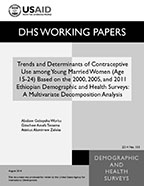
Abstract:
Accessing family planning can reduce a
significant proportion of maternal, infant,
and childhood deaths. In Ethiopia, use of
modern contraceptive met
hods is low but is increasing. This study
aimed to analyze the levels, trends, and
determinants of modern contraceptive use and
changes over time among young married women
in Ethiopia.
The study used data from the three
Demographic Health Surveys (DHS) conducted in
Ethiopia, in 2000, 2005, and 2011. Non-
pregnant, young married women age 15-24 were
included in the final samples, for sample
sizes of 2,157 in 2000, 1,904 in 2005, and
2,146 in 2011. The major statistical
techniques used were logistic regression for
analysis of determinants of current
contraceptive use and logit-based
decomposition analysis of factors
contributing to the recent changes. STATA 12
was employed for data management and
analyses. All calculations presented in this
paper were weighted for the sampling
probabilities and non-response. Complex
sampling procedures were also considered
during testing of statistical significance.
Among young married women, modern
contraceptive prevalence increased from 6% in
2000 to 16% in 2005 and to 36% in 2011. The
study found that young women’s wealth status,
age, religion, education, family size
concordance with husbands, and fertility
preference for spacing or limiting births
were significantly associated with their use
of modern contraception.
The decomposition analysis indicated that
about a third of the overall change in modern
contraceptive use was due to difference in
women’s characteristics. For this component,
changes in women’s age, educational status,
religion, family size concordance, and
fertility preference were significantly
associated with change in modern
contraceptive use. Particularly, an increase
in women’s attainment of primary and above
education accounted for about a tenth of the
change in modern contraceptive use over the
study period.
About two-thirds of the increase in
contraceptive use was due to difference in
coefficients. Change in contraceptive use
behavior among the rural population and among
Orthodox Christians and Protestants showed a
significant contribution to the increase.
Other things being constant, about a third of
the increase in modern contraceptive use in
the past decade was due to change in
contraceptive use behavior among the rural
population.
Programmatic interventions targeting poor,
younger (adolescent), illiterate, and Muslim
women would help to maintain the increasing
trend in contraceptive use among young women
in Ethiopia.
 Trends and Determinants of Contraceptive Use among Young Married Women (Age 15-24) Based on the 2000, 2005, and 2011 Ethiopian Demographic and Health Surveys: A Multivariate Decomposition Analysis (PDF, 598K)
Trends and Determinants of Contraceptive Use among Young Married Women (Age 15-24) Based on the 2000, 2005, and 2011 Ethiopian Demographic and Health Surveys: A Multivariate Decomposition Analysis (PDF, 598K)
